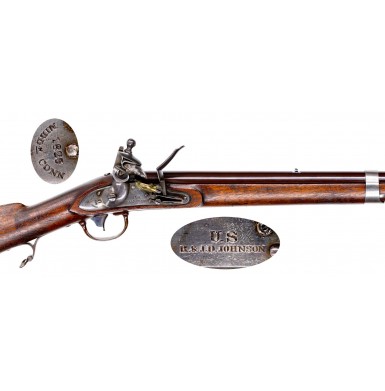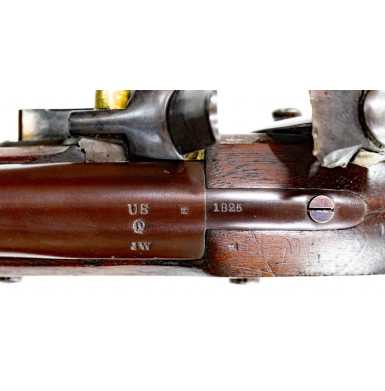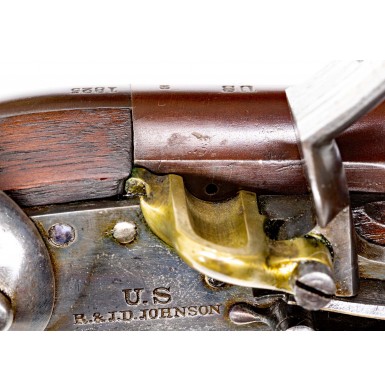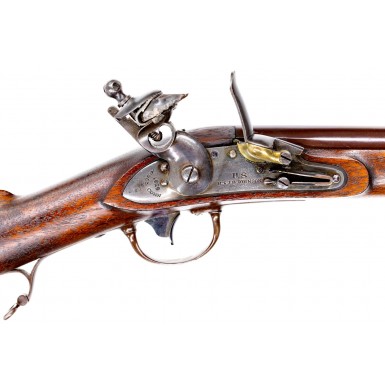Outstanding Condition US Model 1817 Common Rifle - Likely An Experimental Arsenal Musketoon Alteration
- Product Code: FLA-3976-SOLD
- Availability: Out Of Stock
-
$5,500.00
The US Model 1817 Common Rifle was a unique US military long arm in that it was never produced at a National Armory, other than some sample models that were made up at Harpers Ferry, with all of the production of the model being handled by contractors. A total of 38,267 of the rifles were produced by five different contractors between 1819 and 1845. The contractors included Henry Deringer of Philadelphia, as well as Robert Johnson, Robert & J.D. Johnson, Simeon North, and Nathan Starr & Sons, the last four all being located in Middletown, CT. Deliveries by the contractors from greatest to least were as follows:
Henry Deringer: 13,000
Nathan Starr: 10,000
Simeon North: 7,205
Robert Johnson: 5,002
Robert & J.D. Johnson: 3,060
Although the rifles were adopted in 1817, it appears that in some cases the US Ordnance Department thought of the rifle as the “Model 1819”. The 1841 Ordnance Manual refers to them as “Common Rifle, Full-Stocked; 1819”, which apparently refers to the first year the rifles were delivered by the contractors. However, most other period sources do use the model designation “Model 1817”.
The US Model 1817 “Common” Rifle was an elegant and graceful flintlock rifle. It was 51 ¼” in overall length and had a 36” long, .54 caliber, round barrel, rifled with seven deep grooves with a high rate of twist for shooting a patched round ball. The barrel was secured to the stock by three spring retained barrel bands and a single tang screw. Initially the barrels and furniture of some of the contract rifles was polished to National Armory Bright and was left unfinished. Later the metal of most of the rifles was finished with a lacquer brown. This change over appears to have happened during fiscal year 1826, meaning that those guns that had been left bright by their manufacturers initially were being browned after July 1 of 1825, when fiscal year 1826 began. This changeover can be documented by additional payments made to some of the contractors for browning the rifles. Whether the guns were delivered browned or bright, the lock was color casehardened, and the hammer and small work (screws, bands, etc.) were blued as part of the heat drawing process. Interestingly, during the period of 1844-45 regulations were modified to state that arms with browned barrels were to have bright barrel bands. As a result, many of the older National Armory Brown arms in storage at the national armories, most notably Springfield Arsenal, had their bands struck bright, with the balance of the gun remaining brown. It is generally believed that any Common Rifles in storage at this time that had not been issued had their bands struck bright, as were the bands of the muskets, to comply with the updated regulations. The existence of a number of extant M1817 Rifles that are browned with bright bands supports this hypothesis. The rifle had an oval patch box inlet into the obverse buttstock for the storage of cleaning implements and greased patches. As originally produced, the rear tang of the triggerguard extended to form a pistol grip, from which a sling swivel was suspended. Later production rifles eliminated the extended finger-rest tang and relocated the lower swivel to the more conventional location of the front bow of the triggerguard. The upper swivel was mounted on a stud below the middle barrel band. The rifle was produced with a fixed, V-notch rear sight and a front sight that was either a brass blade on the upper barrel band or a fixed blade on the barrel near the muzzle. As originally produced, the rifle did not accept a bayonet of any kind. The ramrod was of iron with a brass trumpet shaped tip, to prevent damage to the rifling during the ramming process. The opposite end of the rammer was threaded for the attachment of implements, including a wiper, and ball puller.
The US Model 1817 Common Rifle was extremely popular during its period of use, and most of the guns were delivered to the various states under the terms of the Militia Act of 1808. The rifle saw significant use during the Seminole Wars in the south and during the Mexican American War as well. The rifles continued to serve well into the percussion period, and the National Armories, at the request of the states, altered many of these guns to percussion. The term “Common Rifle” was a period appellation and was used to differentiate between the “common” muzzleloading rifle and the “less common” and certainly more unique Hall’s Patent breech loading rifle. With just over 38,000 of the rifles being produced by all the contractors, the guns are far from “common” in the greater scheme of things, when you consider that approximately 900,000 US Model 1816/22/28 flintlock muskets were produced during the same time frame by the National Armories and about two dozen contractors. That production ratio indicates that roughly two-dozen US M1816 pattern muskets were produced for every M1817 rifle!
With the coming of the American Civil War, thousands of US M1817 rifles, many already altered to percussion, were in state armories around the country. Thousands were in the hands of the Southern states that had seceded, but many were in Northern armories as well. Extant examples exist with state ownership markings from both North and South Carolina, these markings are from the Seminole War era, as well as the state of New Jersey. Another 5,000 US M1817 Rifles were in storage at the Benicia Arsenal in San Francisco in 1861, and many of these rifles were issued to the 1st California Volunteer Cavalry, who fought in the far western theater against Confederate forces in New Mexico and Arizona. Even as late as March of 1863, “Common Rifles” were showing up in Confederate arsenal inventories. With the significant number of M1817 rifles altered to percussion during the 1850s and the early Civil War years, finding a rifle in its original flintlock configuration is very difficult. As such, these guns demand a significant premium when found in original flint condition.
The US Model 1817 Common Rifle offered here is one of the 3,060 guns produced Robert & J.D. Johnson. It may also be the only surviving example of what appears to be an arsenal modification or alteration to “musketoon” or “carbine” length, which may have been an experimental or prototype exercise. The firm of Robert & John D. Johnson was a short-lived partnership that received a single contract to deliver 3,000 US M1817 Rifles on December 10, 1823. The rifles were delivered between 1824 and 1828, with 220 delivered the first year, and with the subsequent deliveries being 740 rifles (1825), 1,080 (1826), 520 (1827) and 500 (1828), for a total of 3,060 rifles delivered and accepted by the Ordnance Department. The firm received extra payment for browning 1,780 of the rifles, which suggests that the rifles delivered in fiscal years 1824 (220), 1825 (740) the first 320 delivered early in FY1826 were finished bright and the balance were browned. Due to the very small contract received by R&JD Johnson for these rifles, they only delivered 8% of the total number of US M1817 “Common Rifles” produced.
The gun offered here is in about EXCELLENT condition overall and as noted appears to be an absolutely authentic period alteration to musketoon length. The barrel has been shortened from 36” to 25”, which reduced the overall length of the gun to 40 ¼”. As part of this process the forend was commensurately shortened, the middle band was removed, and the double-strapped front band was relocated to roughly the location of the original middle band. This new length makes the gun quite handy and very well balanced and would make it very useful for a mounted soldier. By comparison the overall length is roughly ½” shorter than a Model 1843 Hall-North Carbine and slightly less than 1” shorter than the family of US M1847 Musketoons. This cannot be coincidence or by accident and certainly supports my theory that the gun may have been modified during the 1840s when a new series of carbines was being designed. Other indications that this is arsenal work and not the later work of some industrious forger or modern gunsmith are as follows. First, the muzzle is crowned like later delivery (post-1840) Deringer contract M1817 Rifles. While the muzzle face remains flat as on earlier guns, these later rifles had a very subtle bevel where the outer edge of the flat muzzle face meets the outer edge of the barrel. The quality of this work and the mere attention to this very minor detail almost certainly precludes anything but period arsenal work. Secondly, the original rectangular base front sight with small blade has been reattached to the now shorter barrel 1 ¼” from the muzzle. This is exactly the location the sight would normally be placed on a full-length barrel. Third, the shortening of the stock was performed so that the stock now ends exactly where the rear edge of the original middle band would have been. This alleviates the need to fill the old band spring mortise hole for the middle band. The upper band is now reset so that its front edge coincides with the original rear edge of the middle band and the band spring for the upper band has been neatly inlet into the stock with extreme precision. Because the pin for this band is much further back than the original design and since the barrel tapers from breech to muzzle, it was necessary for the arsenal to gently relieve a small area on the bottom of the barrel to allow the band spring pin to pass “under” the barrel and be correctly positioned. This is work that only an arsenal would do. In addition, the removal of the middle band meant the loss of the upper sling swivel, so the swivel stud and swivel were relocated to the bottom of the upper band in a fashion quite similar to the Mississippi Rifle. The original ramrod has also been commensurately shortened for use with the shorter barrel and the end has been appropriately rethreaded for use with standard M1817 implements. Finally, the gun remains in original flint and is in exquisite condition retaining nearly all of its original browned finish, with the exception of the bands that were struck bright. The gun shows the matching mating marks of three file slashes or three dots throughout, even on the blued heads of the screws. The bright bands on the rifle suggest the gun was in inventory in a National Armory circa 1844-45, immediately prior to the Ordnance Department starting the process that would result in the development of the M1847 family of musketoons. This design process started in 1846. The modification of this rifle to what would essentially be the standard length for US arsenal carbines and musketoons from the late 1840s through the mid-1850s suggests that this modification may have been performed to determine the optimal sized and barrel length, as well as to test the potential efficacy of a short barreled, rifled carbine. All of this evidence taken together suggests that this gun was altered at a National Armory, most likely Springfield Arsenal, for testing purposes prior to or during the development of the M1847 musketoon series.
As noted, the gun remains really outstanding condition with the barrel retaining most of its lacquer browned finish and most importantly with the gun remaining in its original flintlock configuration. The lock of the rifle is marked clearly, forward of the hammer in two horizontal lines:
U.S.
R.&J.D. JOHNSON
The tail of the lock is marked in two vertical lines:
1825
MIDDN CONN
with the second line in an arc. The lock retains some nicely faded bluish gray-mottling from its casehardened finish with a smoky patina and shows some minor surface oxidation and age discoloration. The brass flash pan has a lovely untouched ochre patina and shows practically no use, with the touchhole similarly crisp and showing no significant use. The barrel is clearly marked at the breech with a
US
P
JW
with the “P” raised in a sunken starburst. The raised “P” is brown with the sunken portion of the marks showing no browned finish. This is a clear indication that the marks were struck after the barrel was finished, thus the finish on the barrel is the original brown. The initials “JW” are those of Joseph Weatherhead, civilian employee of the Springfield Arsenal who had started working at the armory as a machinist in 1818. Eventually, Weatherhead spent some time as an inspector of contract arms, working intermittently between 1822 and 1826. Weatherhead proved 504 barrels at the R.&J.D. Johnson manufacturing facility during calendar year 1825, and also inspected 504 finished rifles there during that calendar year as well. A second, very tiny block JW is present on the left breech flat of the barrel and his matching script JW cartouche is present on the counterpane of the stock as well. The barrel tang is marked with the same date as found on the tail of the lock, 1825. It is worth reiterating that Fiscal Year 1826 began on July 1, 1825. Thus, the majority of the rifles delivered in FY1826 were finished in lacquer brown and many of those guns were actually produced in calendar year 1825.
The barrel retains most of its original lacquer browned finish, with some fading, thinning and minor loss. Most of the loss is around the area of the barrel bands, where movement of the bands has scuffed and worn the finish. It is worth noting that the bottom of the barrel retains nearly all of the original brown as well. As the upper band will not pass over the thicker muzzle area of the shortened rifle with front sight in place, it is necessary to loosen both bands, remove the tang screw and then remove the barrel and bands simultaneously by pushing them all the way forward, lifting the breech plug tang from the stock mortise and then pushing the tilted barrel forward, off the stock. The markings on the barrel remain extremely crisp and clear. The barrel remains nearly completely smooth with some scattered patches of very minor surface oxidation scattered along its length and some tiny areas of lightly scattered pinpricking. The bore of the rifle in in its original .54 caliber configuration and remains in VERY FINE condition. It remains mostly bright and retains extremely deep, crisp rifling, with only some lightly scattered oxidation, a few dark spots, and some very minor areas of light pitting along its length. Most of the furniture retains slightly less lacquer brown finish than the barrel and also shows some lightly scattered pinpricking and minor surface oxidation as well. Only the side plate retains essentially no brown, and as noted the bands have been intentionally struck bright. The appearance and coloration of the brown finish on the barrel and furniture match very well. The screws all retain at least some traces of their original blue, the result of the heat-treating process. The lock of the rifle is in excellent mechanical condition and functions crisply on all positions. As noted, the touchhole is very crisp and completely unmolested. It shows only the most minor oxidation at its face. The hole is well centered in the pan and correctly angled and tapered. The rifle retains its original V-notch rear sight with much of its original thinning blue, as well at its original, relocated front sight near the muzzle. Both original sling swivels are present, the lower one attached to the tail of the extended triggerguard and with the upper swivel relocated located from the removed middle band to the bottom of the upper band. As previously mentioned, the original trumped head, brass-tipped ramrod is present with the rifle as well and has been appropriately shortened. It retains fine threads at the end. The exposed steel portion of the rod’s shank is lightly oxidized with some scattered discoloration. The stock of the rifle is in equally wonderful condition as well and certainly rates about EXCELLENT. The stock remains solid and is free of any breaks or repairs. There are a couple of minor grain cracks present at the tip of the forend, concealed by the upper barrel band and likely the result of stress in that area from the shortening. They are likely to have emanated from the rear of the original middle barrel band retention spring mortise. The stock shows some lightly scattered bumps, dings and handling marks from issue and use. The stock shows no indication of having been sanded and retains extremely crisp lines and sharp edges throughout, as well as a wonderful, feathery texture to the grain. The flat opposite the lock has a crisp and clear script JW cartouche. An extremely tiny block JW is also stamped upside down at the tail of the counterpane. As this rifle was produced in 1825, prior to the changes in regulations for contract arms inspection, no second cartouche of the accepting ordnance officer is present. Additional small inspection marks are present behind the triggerguard, a block AW. This is the mark of a currently unidentified sub-inspector.
Overall, this is a really outstanding example of a specially modified US M1817 “Common” Rifle Altered to Musketoon. The gun remains in its original flint configuration and retains most of its original lacquer browned finish. The rifle was made as part of the smallest contract for these guns, with only 3,060 being produced; representing only about 8% of all M1817 Common Rifles manufactured. These rifles are rarely encountered in original flint and rarely with this much finish. The musketoon alteration is almost certainly the work of Springfield Arsenal, most likely as part of the process of developing the series of musketoons that would be adopted in 1847. Further research could prove fruitful and may be able to definitively prove my hypothesis. Concrete evidence could well establish beyond the shadow of a doubt that this is the rare experimental gun I believe it to be. The wonderful gun is very reasonably priced considering its overall rarity and high state of preservation. I have sold full-length examples of these rifles in similar condition for close to 5-figures and if this is proven to be what I think it is, the gun will definitely be worth well into the 5-figure range. This may be a singular opportunity to own an extremely rare and high condition gun for a very reasonable price.
SOLD
Tags: Outstanding, Condition, US, Model, 1817, Common, Rifle, Likely, An, Experimental, Arsenal, Musketoon, Alteration
















